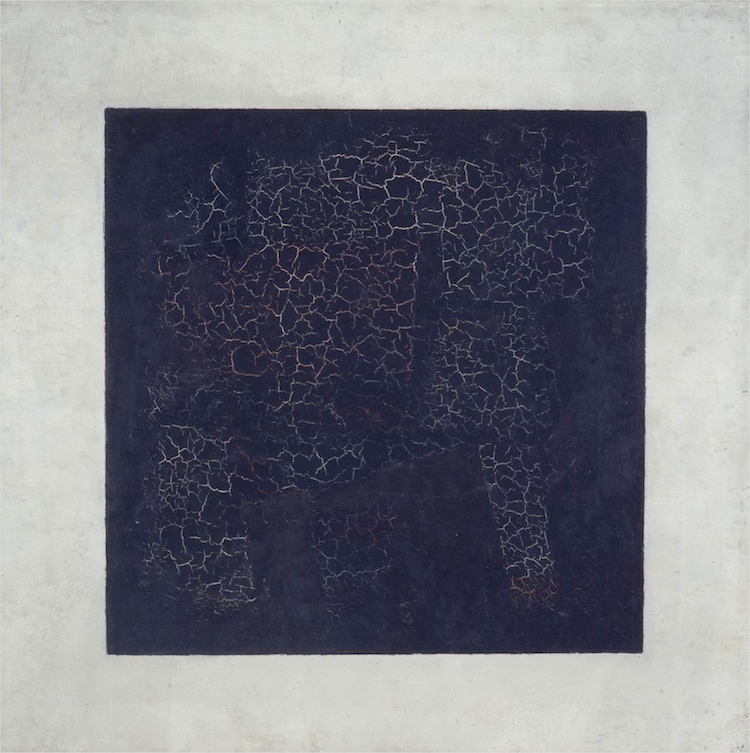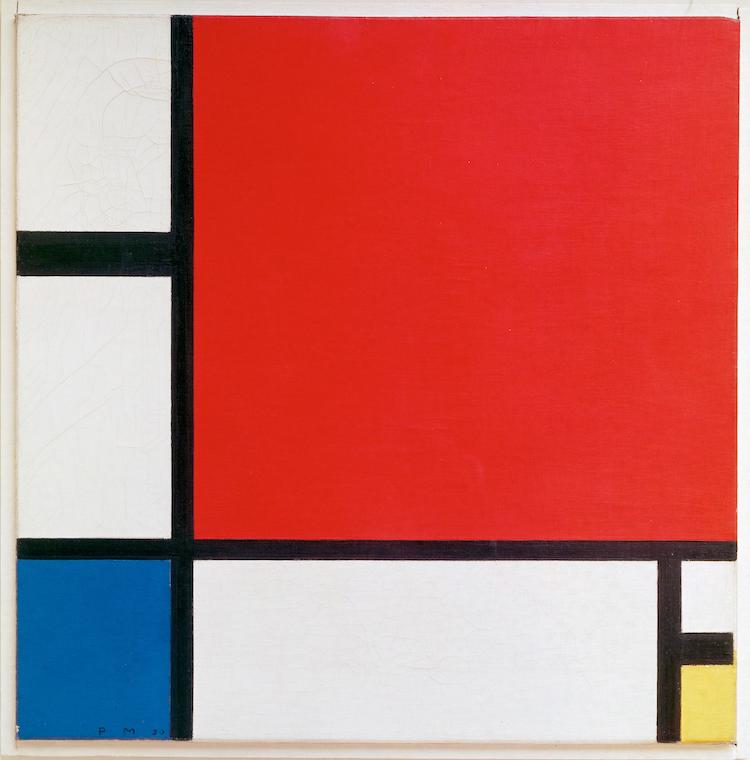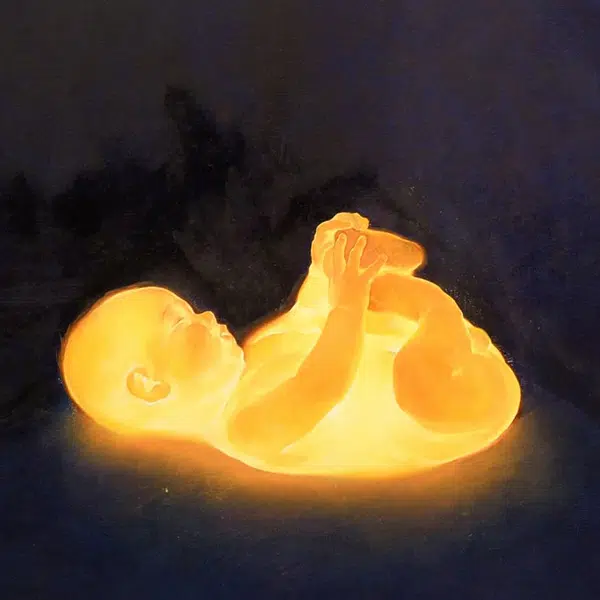
After centuries of tradition, abstract artists sought to make paintings that didn't abide by conventional “rules” like naturalism and perspective. This radical style resulted in powerfully lyrical paintings that emphasized color, composition, and emotion.
Dutch painter Piet Mondrian, for example, created Composition with Red, Blue, and Yellow, which eloquently sums up his aesthetic philosophy utilizing straight lines and primary colors. Likewise, Kazimir Malevich's Black Square is an oft-cited abstract piece due to the purity of its simplicity. Other trailblazers like Hilma af Klint and Wassily Kandinsky created canvases that also left their mark by proving there are infinite ways to capture human experiences in the abstract.
Here, we will explore 10 famous abstract paintings and uncover what it is that made them so important.
Broaden your art history knowledge by learning about these 10 famous abstract paintings.
Hilma af Klint, No. 7, Adulthood, 1907

Hilma af Klint, “No.7, Adulthood,” 1907 (Photo: Wikimedia Commons, Public domain)
Although she is not as well known as many of the male artists of her time, Swedish artist Hilma af Klint was a pioneering abstract artist whose radical paintings predate many of her male contemporaries. She requested that her large body of work—most of which was never exhibited during her lifetime—remain unseen until 20 years after her death. No. 7, Adulthood is part of Af Klint’s The Ten Largest series. The collection represents the stages of life, including childhood, youth, maturity, and old age. They combine botanical elements and recognizable organic objects that reference birth and growth. This huge canvas, measuring 3 meters high and 2 meters wide, was painted on paper, on the floor of the studio, and then pasted onto a canvas.
Af Klint interprets adulthood in full bloom by painting various free-flowing shapes in different sizes and colors set against a lilac background. The central yellow symbol resembles a flower, while spirals and biomorphic forms are symbols of growth and fertility.
Wassily Kandinsky, Composition VII, 1913

Wassily Kandinsky, “Composition VII,” 1913 (Photo: Tretyakov Gallery via Wikimedia Commons, Public domain)
Russian art theorist and painter Wassily Kandinsky used color and abstract forms to communicate different human experiences. Many of his pieces are inspired by music, and he believed that sounds could be found in his brushstrokes.
Composition VII was made when the artist was living in Munich, Germany. While the composition may appear chaotic at first glance, Kandinsky spent months devising it, creating over 30 sketches in oil and watercolor before he made the final piece. The theme of this painting is battle and redemption. Some of the symbols, including boars, mountains, and figures, can be spotted within the labyrinth of colors and symbols.
Kazimir Malevich, Black Square, 1915

Kazimir Malevich, “Black Square,” 1915 (Photo: Tretyakov Gallery via Wikimedia Commons, Public domain)
Russian artist Kazimir Malevich honed his painting skills in numerous styles, but ultimately became best known for his Suprematist abstract art, which relied on geometric shapes. Black Square is his most iconic painting, which he replicated four times with slightly different variations.
The 1915 version is the first of these works and is considered by art historians and critics as a pivotal work of modern art, and often referred to as the “zero point of painting.” Malevich, himself, said of the work: “[Black Square is meant to evoke] the experience of pure-objectivity in the white emptiness of a liberated nothing.”
Paul Klee, The Twittering Machine, 1922

Kurt Schwitters, “Das Undbild,” 1919 (Photo: MoMA via Wikimedia Commons, Public domain)
Swiss-born German artist Paul Klee had a lot in common with his contemporary Wassily Kandinsky. Both artists were members of the German Expressionist group Der Blaue Reiter, and both were deeply influenced by the connection between music and painting. The Twittering Machine is Klee's most famous depiction of sound. It depicts a flock of birds on a wire with a cranking mechanism. Klee made this mixed-media illustration with watercolor, ink, and oil.
Piet Mondrian, Composition with Red, Blue and Yellow, 1930

Piet Mondrian, “Composition with Red, Blue, and Yellow,” 1930 (Photo: Kunsthaus Zürich via Wikimedia Commons, Public domain)
After painting in a realistic style for years, Dutch artist Piet Mondrian joined the abstract art movement and quickly become a groundbreaking figure. He formed his own philosophy on an abstraction called neoplasticism (also called De Stijl), describing it as the following: “This new plastic idea will ignore the particulars of appearance…on the contrary, it should find its expression in the abstraction of form and color, that is to say, in the straight line and the clearly defined primary color.” Composition with Red, Blue, and Yellow is a well-known example of these ideas.
Wassily Kandinsky, Composition X, 1939

Wassily Kandinsky, “Composition X,” 1939 (Photo: Kunstsammlung Nordrhein-Westfalen via Wikimedia Commons, Public domain)
The last in his series of Compositions, Composition X is the pinnacle of Kandinsky's exploration of expression through nonrepresentational form. The organic shapes were influenced by the biomorphic figures of Surrealism while the colors express the inner emotions Kandinsky experienced near the end of his life. The black of the background represents the cosmos and the end of life while allowing the colored sections to stand out. The painting illustrates the circle of life and the emotional ups and downs that everyone in the world experiences.
Paul Klee, Death and Fire, 1940

Paul Klee, “Death and Fire,” 1940 (Photo: Zentrum Paul Klee via Wikimedia Commons, Public domain)
Klee painted Death and Fire in 1940, just a few months before his death in June of that year. He was suffering from a condition known as scleroderma, which caused painful joints and rashes on his hands. This explains why his work during this period became increasingly simplistic, and Death and Fire is a key example of this.
Klee was influenced by primitive art in the past, but this painting is particularly simplistic and critics even likened it to the style of cave paintings. An illustration of mortality, the oil-on-jute piece depicts a central human skull-like motif featuring the word “tod” (the German word for “death”). “Tod” can be found again in the “T” shape of the figure's raised arm, the golden orb (O) in its hand, and the D shape of its face.
Mark Rothko, Yellow, Pink, and Lavender on Rose, 1950
The name Mark Rothko immediately brings to mind canvases of large flat areas of color. The Russian American abstract artist specialized in color field painting, which describes art that uses large flat areas of color. Rothko experimented with an array of color combinations to communicate different human experiences and emotions. Yellow, Pink, Lavender on Rose is one of his earlier pieces from the 1950s. The warm juxtaposition of colors evokes a sense of joy.
Barnett Newman, Vir Heroicus Sublimis, 1951
Another color field pioneer, American artist Barnett Newman believed, “A painter is a choreographer of space.” He invented what he called the “zip,” which is a band of vertical color that set his work apart from his fellow abstract expressionists.
His painting Vir heroicus sublimis (“Man, heroic and sublime”), measures an epic 95 by 213 inches and was his largest painting at the time. It features large fields of bright red that are broken up by the occasional, vertical “zip” lines. With its overwhelming scale, Newman attempted to evoke a strong reaction from the viewer and completely envelop them—and their personal space—in the vibrant hue.
Helen Frankenthaler, Mountains and the Sea, 1952
American artist Helen Frankenthaler developed her own breakthrough technique for filling canvases with large fields of color. She invented the “soak-stain” process, which involved pouring turpentine-thinned paint onto the canvas. This technique produced vibrant, misty compositions that resulted in an entirely new look and feel to the texture of the canvas. Mountains and Sea (1952) was the first artwork in which Frankenthaler used this process, and when fellow color field artists Morris Louis and Kenneth Noland saw the work, they promptly embraced the method, too.
Related Articles:
20 Famous Paintings From Western Art History Any Art Lover Should Know
5 of René Magritte’s Most Famous Paintings That Capture the Surrealist’s Fascinating Mind
5 of Renoir’s Most Famous Paintings That Any Impressionism Lover Should Know
5 Famous Beach Paintings From Art History That Capture Serene Summer Days

























































































